This rosemary pine beard balm is great for beards and smells amazing. It is easy to make and is also great for gift giving. Learn how to make this homemade herbal and foraged woodsy beard balm!
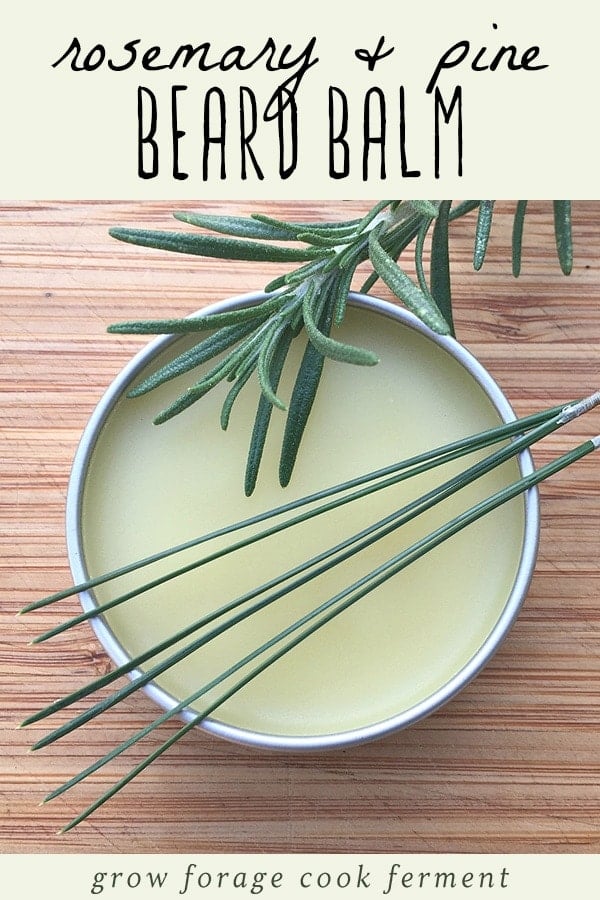
Want to save this post for later?
Homemade Woodsy Pine Beard Balm with Rosemary
I have something a little bit different for you today.
Well, it’s not that different, as I’ve done plenty of DIY herbal products for you before, including an herbal salve which is a very similar process.
I made rosemary beard oil before, and it was quite nice.
But I really like the idea of a beard balm, as it has some added ingredients that help to moisturize and condition both the beard and the face. It’s also more portable, and has a great pine and rosemary scent to it, with a slight hint of orange.
This woodsy rosemary pine beard balm is made especially for bearded people. I’m going to show you how to make it so you have a great homemade herbal gift for someone special!
Related: Juniper Spice Beard Balm Recipe
Get more of my favorite food, drink, medicine, and body care recipes that use pine, fir, spruce, and other conifer needles in my ebook Foraged Conifer Recipes for Body, Mind, and Health!
Make the Rosemary & Pine Infused Oil
There are many different carrier oils you can choose from when making your infused oil.
I like to use a blend of olive, coconut, sweet almond, and jojoba. These are all good for the skin and hair, particularly jojoba. Argan oil is another common one for hair and beard care.
To make the infused oil, gather some fresh green pine needles and a few springs of fresh rosemary, and place them in a jar.
Completely cover them with your carrier oils of choice (I like to use a blend of olive, coconut, sweet almond, and jojoba for this beard balm) and let sit in a dark place for several weeks.
Related: How to Identify Conifer Trees: Pine, Fir, Spruce, Juniper & more
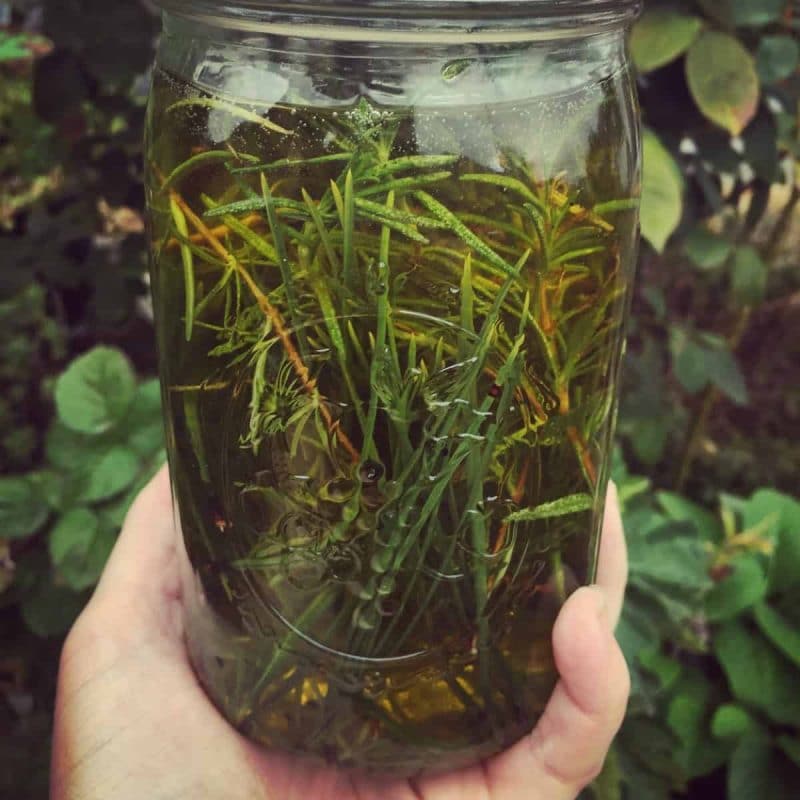
Make the Rosemary Pine Beard Balm
Once you are ready to make the beard balm, strain out the pine needles and rosemary from the oil. It will be a nice green color and will smell amazing.
This recipe makes about 6 ounces of beard balm. You will need a container (or containers) to keep it in. I used 2 ounce tins, which would make you three balms total (you can purchase tins from Mountain Rose Herbs).
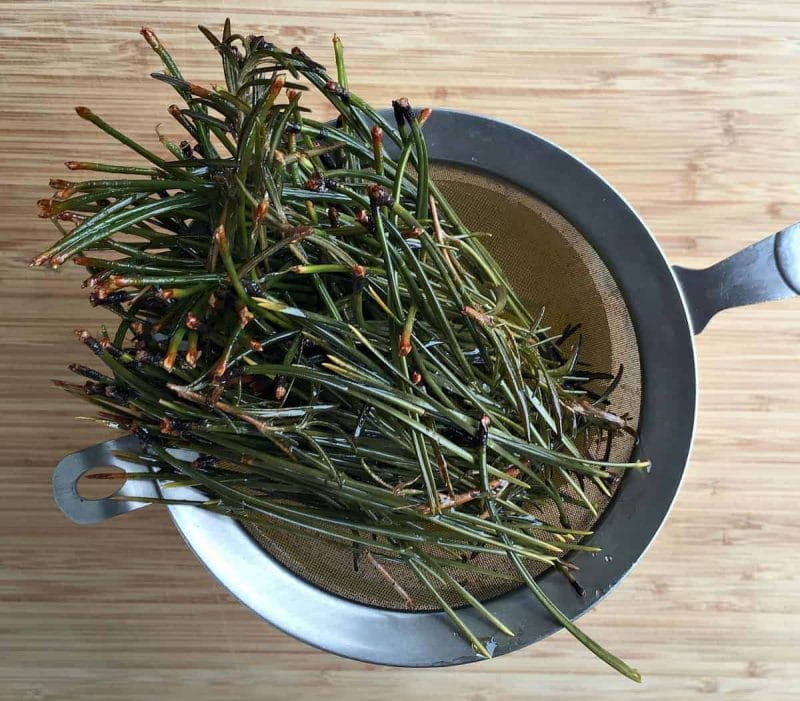
Use a double boiler, or make one with a smaller pot, bowl, or glass pyrex measuring cup over an inch or so of simmering water.
If you use the glass measuring cup like I did, put something in the bottom of the pot that it can rest on, such as a canning jar lid.
Put the infused oil and beeswax into the top container of the double boiler.
Note that I am making a much larger batch in these photos than the amounts I give in the recipe.
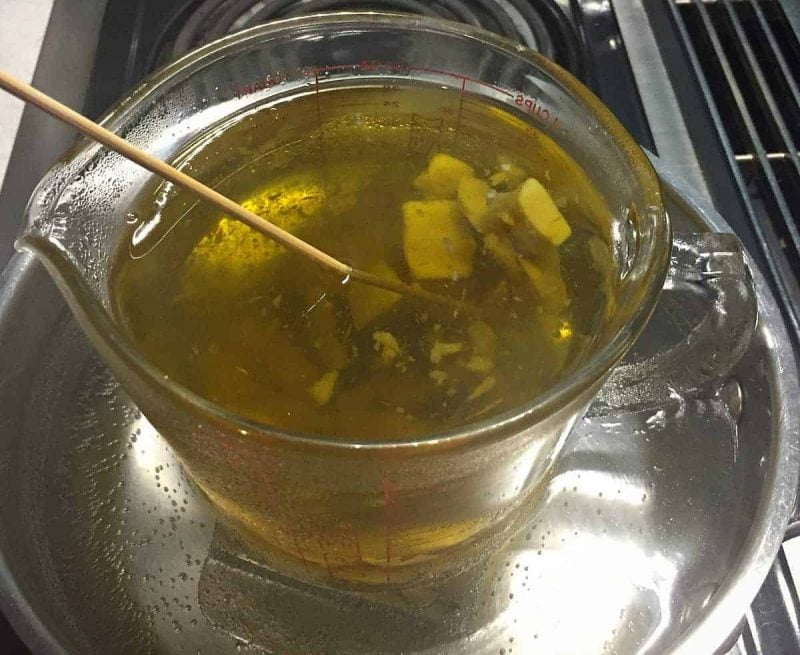
Stir it as it heats up and the beeswax will slowly melt. A wooden skewer works well as a stir stick.
Once the beeswax is almost completely melted, add the shea butter.
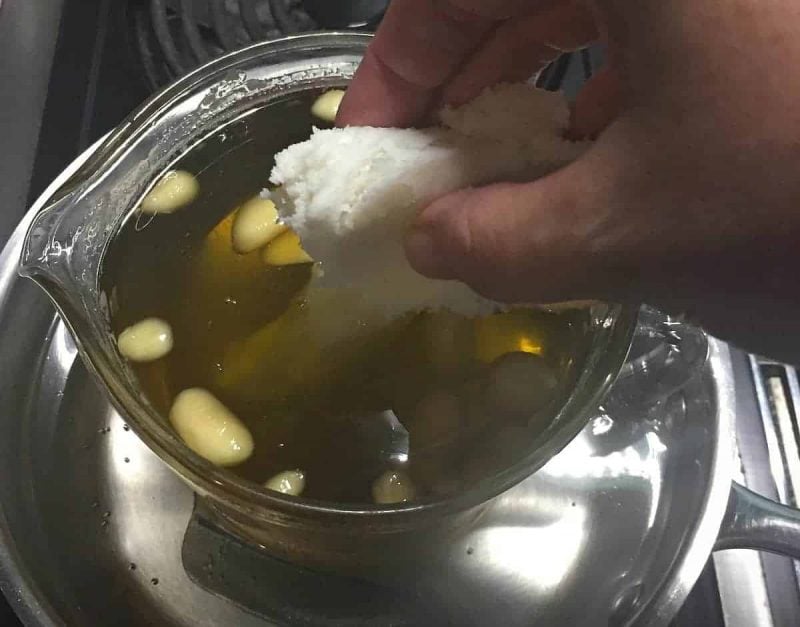
Continue to stir, and the shea butter will melt rather quickly. Once everything has liquefied, stir in the essential oils.
Then carefully pour the mixture into your tins or jars.
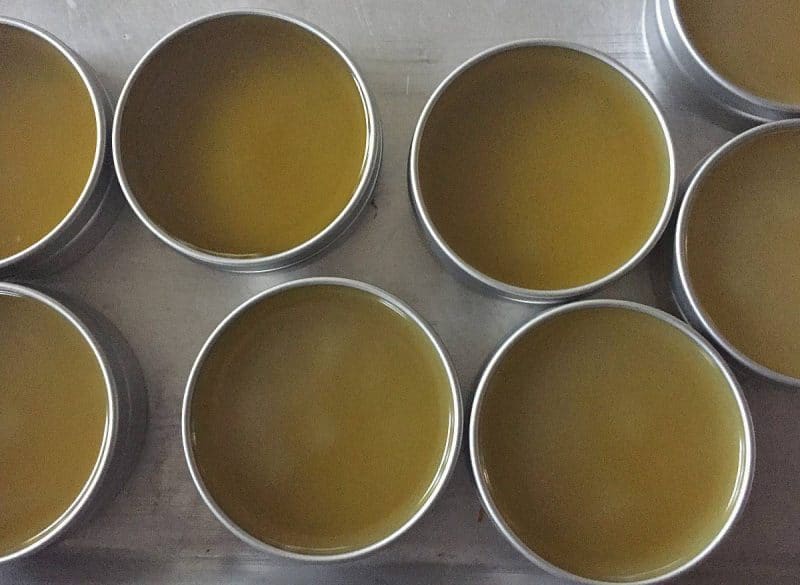
Let the beard balms cool undisturbed for several hours. They will harden as they cools.
Soon you will have a luscious and wonderful rosemary pine beard balm on your hands.
Speaking of hands, this will also work wonders on dry and cracked hands and feet. It’s definitely multi-purpose!
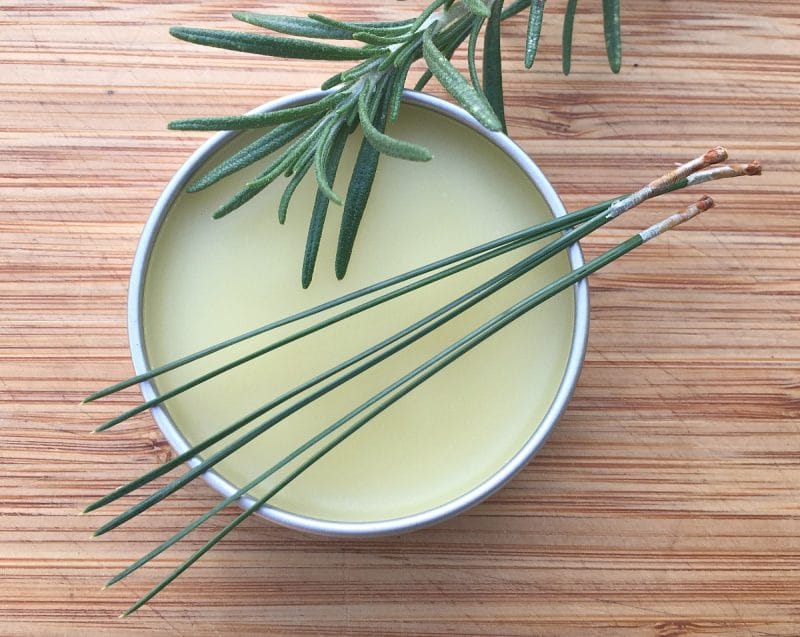
This beard balm smells amazing, and is for sure woodsy and rustic, but not overpowering. It will make a beard smell good as it softens and repairs it. Perfect!
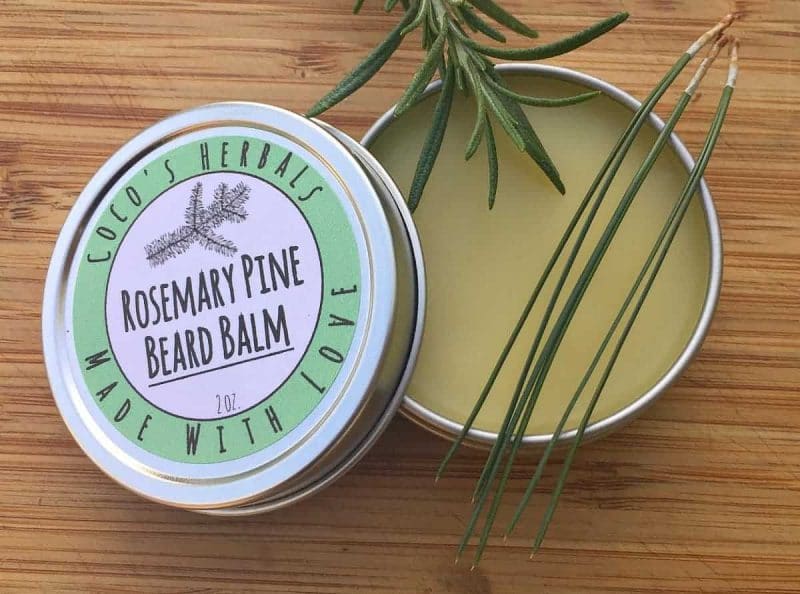
Happy beard balm making!
Beard & Hair Care Recipes
Discover my other beard and hair care recipes! You can also see my post on DIY Herbal Gifts for Men!
Get more pine needle recipes here: 30+ Pine Needle Recipes: Drinks, Desserts, Syrups, Balms & More!
Rosemary Pine Beard Balm
Equipment
Ingredients
Rosemary and Pine Infused Oil
- ¼ cup fresh green pine needles
- 4-5 sprigs sprigs fresh rosemary
- 3/4 cup carrier oil I like to use a blend of olive, coconut, sweet almond, and jojoba oils
Rosemary Pine Beard Balm
- ½ cup rosemary and pine infused oil
- ¾ ounce beeswax
- ½ ounce refined shea butter, unrefined can be used but is scented
- 6 drops rosemary essential oil
- 6 drops pine essential oil
- 3 drops sweet orange essential oil
Instructions
Rosemary Pine Infused Oil
- To make the infused oil, gather some fresh green pine needles and a few springs of fresh rosemary, and place them in a jar.
- Completely cover them with your carrier oils of choice and let sit in a dark place for several weeks.
- Once you are ready to make the beard balm, strain out the pine needles and rosemary from the oil. It will be a nice green color and will smell amazing.
Rosemary Pine Beard Balm
- Put the infused oil and beeswax into the top container of a double boiler.
- Stir it as it heats up and the beeswax will slowly melt. A wooden skewer works well as a stir stick.
- Once the beeswax is almost completely melted, add the shea butter. Continue to stir, and the shea butter will melt rather quickly.
- Once everything has liquefied, stir in the essential oils.
- Carefully pour the mixture into your tins or jars.
- Let them cool undisturbed for several hours to set up.
Notes
- Due to the low water content in rosemary and pine needles, they can be either fresh or dry to make the oil infusion.
- When making beard balms, I like to use a blend of olive, coconut, sweet almond, and jojoba oils. You don’t have to use all of those, but I definitely recommend using some jojoba oil as it is very nourishing for the beard.
- Make a homemade double boiler with a smaller pot, bowl, or glass pyrex measuring cup over an inch or so of simmering water. If you use the glass measuring cup, put something in the bottom of the pot that it can rest on, such as a canning jar lid.


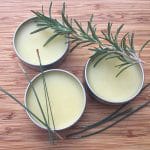

Could you use fir needle essential oil instead of the pine essential oil?
If you have dried pine needles that have been dried for a few weeks are they still potent enough to use?
Thank you!
To your first question, absolutely! And to answer your second question, you can use either!
Do you cover the jar while you let it sit or do you leave the jar uncovered?
The jar should be covered.
Thank you for this recipe! I look forward to making it. Question: Does the sweet orange essential oil give the balm a distinctly orange smell? How do you think the balm would smell without the addition of that oil, or with just a drop or two of the orange?
Hi Pamela. It does give it a slight orange smell that’s balanced with the rosemary and pine needle essential oils, but if you were to omit it, I think it’ll likely have a more upfront rosemary scent.
What is the shelf life of this balm?
It can last 12+ months when stored in a cool, dark location.
Wondering if there is anything else this could be used for besides beards?
You could use it for anything. It’s great as a hand or body balm for dry skin.
Does chopping the pine needles help the infusion or it’s unnecessary? Thanks!
Hi Anne. It’s unnecessary, but you can if you want.
Hi there! This recipe looks amazing! Eventually I will infuse oils, but for now I am making this recipe without the infused oils. As for essential oils, would you recommend adding more since I don’t have the diffused oil for scent? What dilution would you recommend 2%? Thank you!
Hi Lauren, I would still use the same amount of essential oils as called for in the recipe as they carry a pretty good scent.
Does this beard-balm ruin pillowcases (whether it is used as a beard-balm OR a skin conditioner)?
Thank You,
DW
Not that I’m aware of.
Hello! Would I be able to make the oil with dried pine needles and rosemary? I have access to fresh rosemary, but unfortunately I can only get pine needles by ordering them online. Thanks!
Yes, definitely. I prefer to use dried herbs for oil infusions as fresh can leach moisture into your oil and cause it to spoil more quickly.
First, thank you for sharing your recipes. Love them. I have three bearded sons, so this one is definitely going to get used.
Curious though, would there be a difference in the pine needles from summer to winter, I wonder? And if so, which, do you think, would be a better time to harvest them for this particular purpose?
Thanks again!
I’m just wondering how you use this after it’s made. Does one just rub a small amount into the beard or what?
I want to know, too!
Yes, you can just warm it between your hands and rub it through your beard.
I was so excited to start infusing my oils but when I checked on them after about a week the whole thing smelled horribly rancid! My pine needles had dried for a few days but the rosemary was fresh. Do you think the rosemary was the culprit?? Any other ideas about what I might have done wrong? Thanks!!
Collected some pine needles while in New Mexico and rosemary from my garden. Infusing them in a combination of olive, almond, caster oil, and jojoba. Cannot wait!!!! I’m so excited. My two son-in-laws have been asking for beard balm for over a year. I know this will be amazing! Thank you!!!
Thanks for sharing this awesome stuff. My beard is always wanted some special care because it is so dry and rough, I will surely try this beard balm recipe!
Is it ok to use a jar (for infusing the oils) that is much bigger than your plant material/oil blend takes up? As in, has a lot of room and air at the top? Or should you pretty much always use a jar that will be totally filled up with your plant materials/oils. Thanks!
Yes that is fine!
Hola,
Una pregunta el romero y el pino los llenaste de aceite o alcohol? ¿Que tipo de aceite puedo usar? Aceite de oliva o de almendras o puede ser cualquiera?
Gracias
Llene el frasco con aceites y anada el pino y el romero. Cualquier aceite del portador funcionaria, pero una mezcla de aceituna, de coco, de almendra o de jojoba seria el mejor.
Is there an alternative to Shea Butter…allergies
Yes, you can use any of the other butters listed here on the Mountain Rose Herbs website, cocoa, mango, or kokum: https://www.mountainroseherbs.com/catalog/ingredients/butters
I was wondering… Why do you add more pine and rosemary essential oils to the mix when you’ve already made your own oils? And will it still have a strong scent if I don’t add the essential oils? Thanks!
The rosemary essential oil adds more of the benefits of rosemary, and they both add to the scent. You can certainly make it without them, but the finished product will smell extremely mild.
Hi – I like this recipe. What was your carrier oil of choice? And is the oil meant to fill the entire glass?
Would you recommend adding vitamin e as preservative? How much would you recommend? Thank you!!!
I don’t ever use vitamin e, so I can’t really tell you how much to use.
Vitamin E is not a preservative.
I often add vitamin E to my balms. How much I add usually depends on how much I have on hand – no set amount. Maybe a teaspoon to a half-pint?
How many weeks you recommend leaving it in a dark place
At least one week, but more is better!
Hi, is there an ingredient you can use in stead of beeswax? I would love to make a vegan beard balm! Also, what type of container can u use for this?
Yes, you can try making it with carnauba wax, which is plant derived: https://www.mountainroseherbs.com/products/carnauba-wax/profile I’ve never tried it myself, so I’m unsure of the exact results, but I bet it would work just fine. Any small glass container or tins would work well.
Hi! I want to make this this weekend and I have a question. The measurements just seem so small! Yet, I’ve never made a beard balm before so I am no expert. A half ounce of beeswax and 3/4 ounce of shea butter? I just want to confirm these measurements. I have three (2 oz.) containers so I just want to make sure it will make enough for all three :) Thank you!
Well, it’s 3/4 ounce beeswax and 1/2 ounce shea butter by weight (you had it backwards), yes… those amounts are right, but don’t forget the 1/2 cup infused pine and rosemary oil! That makes up the bulk of the recipe, the beeswax firms it up, and the shea butter makes it rich and creamy. It should fit perfectly in three 2 oz. containers!
hello i would like to know if i have to dry the pine needles and rosemary or store them in the jar with the oils and let them sit as directed ??? .. and can u please tell me about how much virgin oil and others oils mentioned does it require …thank you very much
It is good to let the pine needles and rosemary dry for a day or two before making your infused oil. You can use any oils that you like and at any ratio that you like. I did approximately equal parts of the four oils, olive, coconut, sweet almond, and jojoba. Hope that helps!
thank you so much
For what it is worth… your instructions say “gather some fresh green pine needles and a few springs of fresh rosemary, and place them in a jar” without mentioning the “it is good to let the pine needles and rosemary dry for a day or two before making your infused oil” part. I’m hoping it doesn’t make a huge difference because I didn’t see the second part in the comments until three weeks later.
Since both pine and rosemary are low in water content it really isn’t an issue either way. I’ve done it both ways with great results. Sorry for the confusion!
My recipe turned out lovely, so it was not an issue at all. I’ve had compliments from every one who has tried it … and I love it too. Thanks for sharing!
Hi, I was wondering if I need to dry the rosemary and pine needles (if they’re not already brown) prior to infusing? Any infusion I’ve seen says to use dry herbs, so the water content doesn’t contaminate the oil faster.
Yes, I usually let them sit out for a couple of days beforehand. They don’t need to be brittle, but a little bit dry is good. Neither pine needles or rosemary have a high water content, so it’s not a huge worry like with some other herbs.
This recipe sounds awesome! Wondering what type of pine needles and also how much? I didn’t see a measurement for the amount of pine needles and rosemary to infuse?
I used lodgepole pine needles, but any variety of pine will work. There is no measurement on the rosemary and pine because I didn’t measure them :) Making infused oils isn’t an exact science, so I usually just fill up my jar with herbs or plant material, leaving a bit of space on the top, then cover it with oil. I made a quart jar of oil and I did approximately 4-5 springs rosemary and a few good handfuls of pine needles.
is the rosemary just a scent thing or is is absolutely necessary for this balm to work? I cannot use rosemary oil in things for my husband.
I used rosemary because it is well known to be great for the hair and scalp (plus it smells good, too), but there are other herbs that can be substituted. Mint, chamomile, calendula, nettles, and sage are all good choices for hair and beard care.
what kind of Pine Needles do you use (i suspect the pine needles in australia might be different)
The pine needles I used were from a lodgepole pine. I think you’re right that they are different in Australia, but I’m not exactly sure what the difference is and if they can still be used or not.
This is a winner! I am counting the bearded men in our family for Christmas gifts! Thank you…it looks great, as always!